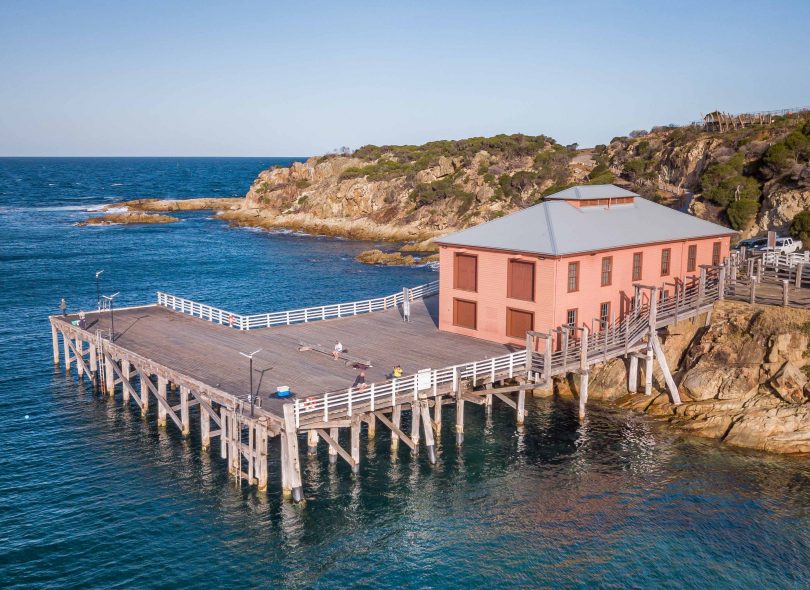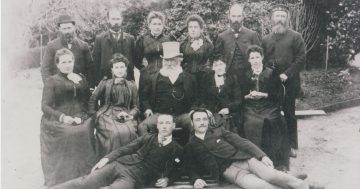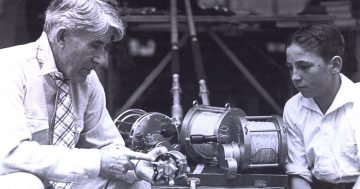
The wharf is an icon of Tathra. Photo: Skye Owen.
UPDATED: Unfortunately, due to bad weather, the event has been cancelled.
It’s been 160 years since the iconic Tathra Wharf was built to create a facility for importing and exporting goods across the state.
Today, Saturday, 2 April, the Tathra Wharf Museum is celebrating the landmark with free entry for all to dive into Tathra’s deep nautical history.
Tathra Wharf Museum president Lynneeta Waterson, a born and bred local, said the wharf established the coastal town.
“The town of Tathra did not exist prior to that,” Ms Waterson said.
“There was nothing here before that, there were no houses, the storage shed was the first building.”
Following the storage shed’s construction on the wharf, Tathra’s first house was built on the top of the hill.
Later a post office and two hotels were built, one in the 1870s, that burnt down, and one in the late 1880s, that remains today.
“[The wharf] is what established Tathra, it is also the last surviving original deep-water wharf on the eastern seaboard of NSW and perhaps Australia.”
Ms Waterson said the wharf was to be demolished in the 70s, however the town rallied and it took 10 years of lobbying to save it.
Through simple cake stalls, raffles and government grants, the funds were raised to save the wharf.
“Only the finance available allowed for what exists now,” she said.
“We have received another amazing grant so the work is to start very soon, with millions to replace all the pylons along the front as a lot of it is rotting.”

The Tathra Wharf Museum will have free entry for all on Saturday, 2 April, to mark a milestone in its history. Photo: Skye Owen.
Tathra was originally built to provide access for shipping local goods. Ms Waterson said getting the goods shipped to Sydney was very difficult for farmers.
“There were no roads … any perishables like cheese and butter would have gone off,” she said.
“Then a basic jetty was built with a storage shed here in the existing position, which grew to a larger shed, to a larger jetty, to a wharf with a big storage shed.”
In 1862 a platform was constructed over the jetty, where sailing ships, paddle steamers, motorised boats and passengers were able to dock.
Ms Waterson said passengers stopped going on trips via the wharf in 1929, after trainlines and roads were created to Cooma, Nimmitabel and Nowra.
Goods stopped being shipped in 1954, when the last boat came.
“When the boat came into town, it would blow its whistle twice and everyone would gather around and come running down to see what treasures people got off the boat, it was a very exciting time,” she said.
Ms Waterson said many locals were yet to visit the nautical museum and she encouraged them to visit today.
“You’ll get to see different things, there’s big rusty objects left there from when it was a functioning wharf, plus a full model of the wharf in its heyday, so to see that, you can basically see how it functioned during the 1930s,” she said.
Tathra Wharf Museum volunteer Skye Owen said she looked forward to having people immerse themselves in the new displays at the museum.
“One of the new displays is about the Tathra arch which doesn’t exist now, but it tells the story behind that and why it disappeared,” she said.
“We’ve got another display about Japanese activity off the NSW coast during WWII.”
David Rogers, a local photographer, will also have his displays of various angles of the wharf, including images of two old-fashioned divers wearing 100-year-old helmets.
For more details, visit Tathra Wharf Museum.









